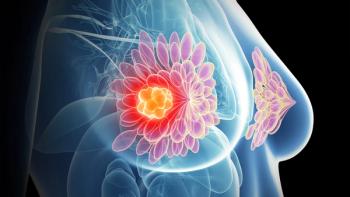
- February 2024
- Volume 18
- Issue 1
Looking More Closely at Breast Cancer in Male Patients
Although breast cancer has historically been associated with female patients, the rates of men with breast cancer have been increasing over the past decade.
Breast cancer has historically been associated with female patients, from the Susan G. Komen marketing with its pink ribbons to the No One Fights Alone campaign. Men with breast cancer are often left to fight the disease in silence. This silence has led to psychological and emotional distress in conjunction with illness-related stigmas.1 Over the past decade, the rising incidence has warranted research to evaluate its rate, prognostic factors, and mortality. Through qualitative studies, researchers are trying to understand how men cope and to reduce the boundaries that lead to social isolation.1
Breast tissue begins to develop in boys and girls at puberty. However, high levels of testosterone and low estrogen prevent the continued growth of breast tissue in males. If breast cancer begins to develop in men, the initial symptom may be described as a “painless lump,” change in size of the breast, dimpling, inverted nipples, and/or nipple discharge.2 Due to decreased breast tissue in men, these symptoms are often noted earlier than in women.
Male breast cancer accounts for less than 1% of the total cancers in the United States.3 In 2023, it was expected to account for 2800 of the estimated 300,590 cases.3 It is still considered rare. However, it is worthy of discussion given the associated stigma and stereotypes. From 2004 to 2014, there has been a rise in cases of breast cancer in males from 7.0% to 10.3%; the overall mortality rate for men is 27.2 % vs 17.4% for women.4
Breast cancer most commonly occurs in men older than 60 years. The median age at diagnosis is 64 years.4 The demographics of breast cancer are highest among non-Hispanic White men, followed by non-Hispanic Black men. The lowest incidence of male breast cancer among all ethnicities occurs in non-Hispanic Asian and Pacific Islander men, accounting for 0.5 per 100,000 cases per year.5 Mortality rates are higher among non-Hispanic Black men than non-Hispanic White and Hispanic men.5
The most common form of breast cancer is invasive ductal carcinoma, whereas ductal carcinoma in situ is rare in men. Upon presentation, there is a high incidence of metastasis and lymph node involvement.6 The tumors typically are highly invasive, moderately differentiated lesions that are estrogen receptor positive and HER2 negative. There is a higher incidence of BRCA2 mutations with low androgen levels in men compared with women with breast cancer.6
Beyond older age, the risk factors for male breast cancer are still not clear, although a family history of breast cancer, Klinefelter syndrome, obesity, gynecomastia, and diabetes have been associated with breast cancer in males.6
The American College of Radiology recommends ultrasonography for male patients younger than 25 years when breast cancer is suspected. For men older than 25 years who have a significant suspicion of cancer, physical exam and mammography are recommended. Once a tumor has been confirmed through a core biopsy, estrogen, progesterone, and HER2 levels should be evaluated for treatment options.7
Male patients who present with localized and operable breast cancer are treated with a mastectomy with an axillary lymph node dissection.8 A lumpectomy and radiation therapy can be considered for patients who meet the criteria for conservation of the breast tissue. Adjuvant chemotherapy includes docetaxel, cyclophosphamide, tamoxifen, aromatase inhibitors, trastuzumab (Herceptin), and pertuzumab (Perjeta).8 Locally advanced breast cancer is treated with neoadjuvant chemotherapy, mastectomy, radiation therapy, and endocrine therapy. And finally, metastatic breast cancer is treated with aromatase inhibitor therapy with gonadotropin-releasing hormones.
Given the rise of male breast cancer cases over the past decade, additional trials are needed to gain insight into its management. As clinicians, we must advocate for the needs of these men as well as identification of barriers that lead to suboptimal treatments for men. There is also a great need for support groups that give men a voice to share their medical journey.
References
- Levin-Dagan N, Baum N. Passing as normal: negotiating boundaries and coping with male breast cancer. Soc Sci Med. 2021;284:114239. doi:10.1016/j.socscimed.2021.114239
- Signs and symptoms of breast cancer in men. American Cancer Society. Updated April 27, 2018. Accessed January 17, 2024.
https://www.cancer.org/cancer/types/breast-cancer-in-men/detection-diagnosis-staging/signs-symptoms.html - Jana BRP. Breast cancer in men overview of male breast cancer. Medscape. Updated August 1, 2023. Accessed January 9, 2024.
https://emedicine.medscape.com/article/1954174-overview - SEER Cancer Statistics Review (CSR) 1975-2018. National Cancer Institute. April 15, 2021. Accessed January 17, 2024.
https://seer.cancer.gov/archive/csr/1975_2018/index.html - Breast recent trends in SEER age-adjusted incidence rates, 2000-2020. National Cancer Institute. Accessed on April 21, 2023.
https://bit.ly/3UE8SOL - Yadav S, Karam D, Riaz IB, et al. Male breast cancer in the United States: treatment patterns and prognostic factors in the 21st century. Cancer. 2020;126(1):26-36. doi:10.1002/cncr.32472
- Giordano SH. A review of the diagnosis and management of male breast cancer. Oncologist. 10(7):471-479. doi:10.1634/theoncologist.10-7-471
- Male breast cancer treatment (PDQ)–health professional version. National Cancer Institute. Updated March 10, 2023. Accessed January 7, 2024.
https://www.cancer.gov/types/breast/hp/male-breast-treatment-pdq
Articles in this issue
almost 2 years ago
T-Cell Engagers Take Center Stage in Large B-Cell Lymphomaalmost 2 years ago
Navigating Difficult Conversations in Cancer Pain Managementalmost 2 years ago
Empower Your Clinical Staff to Meet the Growing Patient VolumeNewsletter
Knowledge is power. Don’t miss the most recent breakthroughs in cancer care.
















































































